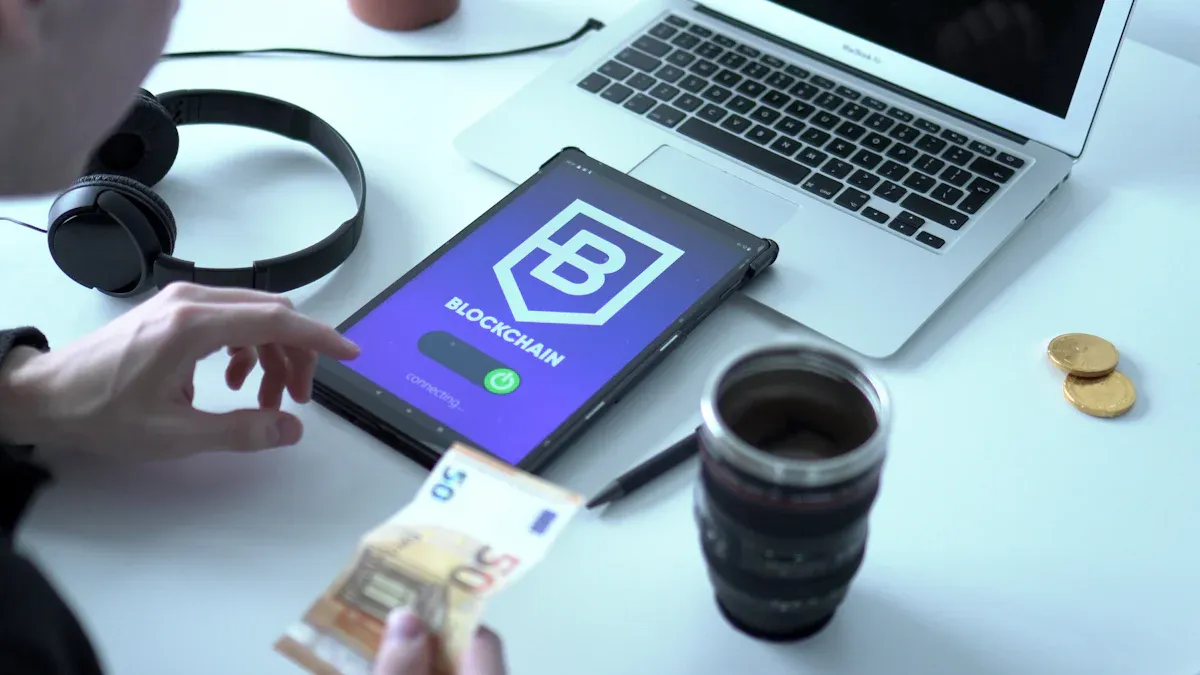- EasyCard
- Trade
- Help
- Announcement
- Academy
- SWIFT Code
- Iban Number
- Referral
- Customer Service
- Blog
- Creator
Exploring Technical Paths for Stablecoins to Enable Instant Payments

Image Source: pexels
Stablecoins, powered by blockchain technology, bypass traditional financial intermediaries to enable 24/7 global payments. This model has ushered fund settlement efficiency into a new era.
Under traditional payment systems, the arrival time for a cross-border remittance is measured in “days.” Today, the time required for payment has been reduced to “seconds”.
The table below clearly illustrates the vast differences in settlement speeds across transaction methods. This near-instant clearing capability is the core advantage of digital assets reshaping the payment landscape.
| Transaction Type | Settlement Time |
|---|---|
| Traditional International Bank Transfer | 1-5 business days |
| Stablecoin Transaction | Seconds to minutes; 24/7 |
Key Takeaways
- Stablecoins use blockchain technology to make global payments extremely fast, just like sending a message.
- Stablecoin instant payments have three main methods: through exchanges, using payment gateways, or via remittance networks converting to cash.
- Exchanges provide massive liquidity for conversions, payment gateways make payments as simple as swiping a card, and cash bridges help unbanked users access stablecoins.
- Stablecoin payments face network congestion and regulatory challenges, but technology is advancing to make payments cheaper and more convenient.
- Choosing a stablecoin payment method depends on whether you prioritize convenience, cost, or control.
Technical Foundations of Stablecoin Instant Payments

Image Source: unsplash
The instant payment capability of stablecoins does not emerge out of thin air; it is built upon several key technical foundations. These technologies collectively form an efficient, reliable, and automated payment infrastructure.
Blockchain: The 24/7 Underlying Rail
Blockchain serves as the underlying rail for stablecoin operations. It is essentially a distributed digital ledger not controlled by any single central entity. This decentralized architecture provides extremely high reliability.
Unlike centralized systems reliant on a single server, blockchain distributes data across thousands of nodes. This eliminates single points of failure, ensuring the network continues uninterrupted even if one node goes offline.
Many mainstream blockchain networks demonstrate exceptional stability, providing assurance for 7x24-hour uninterrupted payment settlement.
| Blockchain Network | Uptime Statistics |
|---|---|
| Stellar | No downtime since 2014. |
| Solana | Over one year of uninterrupted uptime as of this writing. |
Smart Contracts: Automated Transaction Engines
If blockchain is the rail, smart contracts are the automated transaction engines running on it. Smart contracts are programs that encode agreement terms directly into code, stored on the blockchain. When preset conditions are met, the contract executes automatically.
This automation greatly reduces the need for human intervention and third-party intermediaries in transactions. It plays a role in various scenarios:
- Escrow Services: Smart contracts can act as escrow agents, securely holding funds until both parties meet conditions.
- Automated Payments: Contracts can automatically transfer funds from the payer to the payee based on preset times or conditions, without manual operation.
Consensus Mechanisms: Determinants of Transaction Speed
How do all nodes in a blockchain network agree on transaction validity? The answer is consensus mechanisms. This mechanism directly determines the network’s transaction processing speed (TPS), thereby affecting the final stablecoin payment experience. Different consensus mechanisms vary significantly in speed and energy consumption.
| Consensus Mechanism | Impact on Transaction Speed | Explanation |
|---|---|---|
| Proof of Work (PoW) | Slower | Prioritizes security but requires extensive computation and high energy use. |
| Proof of Stake (PoS) | Faster | Selects validators based on staked tokens, reducing computation needed for consensus. |
Choosing a blockchain with a high-performance consensus mechanism is a key step to achieving second-level payments.
Three Mainstream Technical Paths for Instant Payments

Image Source: unsplash
Building on theoretical foundations, the industry has explored multiple technical paths to implement stablecoin instant payment capabilities in real-world applications. These paths have different focuses, meeting user needs in various scenarios. Together, they form the bridge connecting the current digital asset ecosystem with real-world financial activities.
Path 1: Exchange Deposits and Withdrawals
Centralized exchanges (CEX) are the most direct and mature channel connecting fiat and digital assets. Users complete fiat deposits, exchange for stablecoins, and then perform on-chain transfers via exchanges—this is the most basic path to instant payments.
This process typically involves several steps:
- Fiat Deposit: Users deposit USD, EUR, or other fiat via bank transfer into the exchange account.
- Asset Exchange: Convert fiat to stablecoins like USDC or USDT within the exchange.
- On-Chain Transfer: Withdraw the exchanged assets to the recipient’s blockchain address to complete payment.
The core advantage of this method lies in leveraging the massive liquidity of exchanges. Mainstream exchanges process enormous trading volumes daily, ensuring users can quickly complete large conversions.
| Stablecoin | 24h Trading Volume |
|---|---|
| USDT | $118.53B |
| USDC | $13.73B |
However, the efficiency and cost of this path are limited by deposit/withdrawal steps. Fees vary significantly across deposit methods.
| Deposit Method | Fee |
|---|---|
| ACH (USD) | Free |
| Wire Transfer (USD) | $10 |
| SEPA (EUR) | €0.15 |
Withdrawing to bank accounts involves similar varying costs.
Additionally, storing funds on centralized platforms introduces custodial risks. Users must trust the platform to properly safeguard assets and resist external attacks. Historical events show that even large platforms face security challenges, such as internal threats or operational failures potentially preventing user fund access.
Path 2: Seamless Payment Gateway Conversions
For merchants and consumers seeking ultimate user experience, Path 1’s operations are slightly cumbersome. Payment gateways provide a superior solution. They encapsulate complex exchange and settlement processes in the backend, delivering a “seamless” payment experience to users.
Take payment giant Stripe as an example; its solution allows businesses to accept crypto wallet payments from customers while settling in fiat. The technical core is an innovative smart contract. This contract lets customers save crypto wallets as a payment method and authorize recurring payments without manual signing for each transaction.
For consumers, the payment experience is nearly identical to using a credit card. For merchants, they enjoy digital asset benefits without handling on-chain operations or managing private keys themselves.
This model brings significant advantages to merchants, especially in cost and efficiency. Traditional card networks charge 1.5% to 3.5% per transaction, while stablecoin payments can drop to a few cents and eliminate chargeback fraud risks.
The table below clearly contrasts the two payment methods:
| Feature | Accepting USDT Payments | Traditional Bank Payments |
|---|---|---|
| Settlement Speed | Minutes (24/7) | 2-5 business days |
| Transaction Fees | 0.1-1% | 2-5% plus hidden fees |
| Fraud Risk | Transactions immutable, low risk | High chargeback risk |
| Accessibility | Anyone with a crypto wallet | Requires bank account and approval |
This trend has attracted numerous participants. Beyond Stripe, traditional payment networks like Mastercard and Visa have entered the space. Meanwhile, a wave of emerging crypto payment providers is rising, including:
- Paxos: Offers regulated blockchain infrastructure.
- Coinbase Commerce: Leverages its brand for direct crypto payment processing.
- Binance Pay: Integrated with the world’s largest crypto trading ecosystem.
- NOWPayments: Non-custodial gateway supporting over 150 cryptocurrencies.
Path 3: Cash Bridges Integrated with Remittance Networks
A large global population still lacks banking services. For them, the first two paths have high barriers. The third path integrates traditional remittance networks to bridge the “last mile” between digital assets and physical cash.
A typical example is the collaboration between traditional remittance company MoneyGram and the Stellar blockchain network MoneyGram and Stellar partnership. This partnership enables bidirectional digital asset-cash conversion at MoneyGram outlets in over 170 countries.
The user cash-out process is very simple:
- In a Stellar-supported digital wallet, enter the desired cash withdrawal amount.
- Select a nearby MoneyGram outlet as the pickup location.
- Show the wallet-generated transaction confirmation code to the outlet agent to receive cash.
The major significance of this model is that it allows unbanked users to participate in the global digital economy. Users can conveniently convert received USDC or other assets into cash needed for local living.
This collaboration has demonstrated immense social value. It is used not only for daily cross-border remittances but also for humanitarian aid. Aid agencies can send USDC directly to recipients’ digital wallets, who then collect cash at local MoneyGram outlets. Over the past three years, this network has facilitated nearly $30 million in transactions on Stellar.
This innovative model has inspired other companies. Remittance provider Remitly is integrating its global payment network with stablecoin services to offer similar cash withdrawal services, further promoting financial inclusion.
Trade-offs and Future Challenges in Technical Paths
Although the above paths show broad application prospects, the road to seamless instant payments is not smooth. Any technical solution must balance multiple dimensions and face real-world technical and regulatory challenges.
Trade-offs in Speed, Cost, and Usability
The three mainstream paths make different trade-offs between speed, cost, and usability.
- Exchange Path: Offers high liquidity but requires users to manage fiat deposits/withdrawals and on-chain transfers, with a higher operational barrier.
- Payment Gateway Path: Provides the best usability but merchants rely on third-party providers and incur service fees.
- Cash Bridge Path: Greatly enhances financial inclusion but availability is limited by offline partner outlet coverage and operating hours.
Developers and businesses must find the optimal balance among these three core elements based on target users and specific business scenarios when choosing a solution.
Technical Bottlenecks: Network Congestion and Liquidity
Payment experience stability is directly affected by underlying blockchain performance. Network congestion is the primary technical bottleneck, especially on high-traffic networks like Ethereum. Historical events show that surges in network activity drive up transaction fees, impacting payment efficiency.
| Event | Transaction Fees | Impact/Outcome |
|---|---|---|
| DeFi Summer 2020 and NFT Boom | Once reached tens of dollars | Led high-frequency stablecoin activity to migrate to lower-cost blockchains |
| Small Transactions on Ethereum L1 | Prohibitively expensive | Spurred development of Layer-2 networks, reducing fees to cents |
To address this, Layer-2 scaling solutions have emerged. Networks like Arbitrum and Optimism process transactions off the main chain, achieving near-instant confirmations and extremely low costs while inheriting mainnet security.
Additionally, liquidity is the lifeblood of instant conversions. Liquidity pools as core DeFi components allow anytime asset swaps. Sufficient liquidity ensures lower slippage and higher efficiency, key to smooth payment paths.
Regulatory Compliance: The Threshold to Cross
Compliance is a mandatory threshold for stablecoins to achieve mainstream adoption. Global regulators are actively building frameworks to balance innovation and risk.
The EU’s Markets in Crypto-Assets Regulation (MiCA) is a representative example. It categorizes crypto assets and imposes strict authorization, capital, and governance requirements on issuers.
Meanwhile, anti-money laundering (AML) and know-your-customer (KYC) are unavoidable responsibilities for all providers. Under regulations like the Bank Secrecy Act (BSA), issuers must establish risk-based compliance systems, including:
- Implementing customer identity verification (KYC).
- Using blockchain analytics tools for ongoing on-chain transaction monitoring.
- Screening and blocking addresses linked to illicit activities.
These compliance obligations increase operational costs but are necessary to ensure asset security and gain market trust.
Stablecoins, combining blockchain and smart contracts, have opened a new paradigm of efficient, low-cost global instant payments. Whether through exchanges, payment gateways, or cash networks, their potential to reshape the payment landscape is clearly visible.
Despite facing network performance and regulatory challenges, growth momentum remains strong. In 2024, total stablecoin transaction volume exceeded $32 trillion.
Looking ahead, technical solutions are evolving toward greater compliance and usability. With the emergence of central bank digital currencies (CBDCs), a public-private symbiotic diversified digital currency ecosystem is forming to meet broader commercial and individual needs.
FAQ
Are stablecoin payments secure?
Stablecoin payment security depends on multiple layers.
- Technical Layer: Blockchain encryption ensures transactions are hard to tamper with.
- Platform Layer: User fund security relies on the security measures and compliance level of exchanges or payment providers. Choosing reputable platforms is crucial.
Which payment path should I choose?
The choice depends on specific needs.
The core of path selection is balancing usability, cost, and control.
Individual users can choose the exchange path for greater control. Merchants seeking seamless experience are better suited to payment gateways. Users needing cash conversion can opt for cash bridge networks.
Why are stablecoin transaction fees sometimes high?
Transaction fees are influenced by underlying blockchain network congestion. When user activity increases, processing costs (Gas Fee) rise. To address this, the industry has developed Layer-2 scaling solutions that reduce fees to cents.
Do I need a bank account to use stablecoin payments?
Not necessarily. While the exchange path typically requires linking a bank account for fiat deposits/withdrawals, the “cash bridge” path (e.g., MoneyGram-Stellar collaboration) allows users to directly exchange cash for stablecoins or vice versa at partner outlets without a bank account.
*This article is provided for general information purposes and does not constitute legal, tax or other professional advice from BiyaPay or its subsidiaries and its affiliates, and it is not intended as a substitute for obtaining advice from a financial advisor or any other professional.
We make no representations, warranties or warranties, express or implied, as to the accuracy, completeness or timeliness of the contents of this publication.




Contact Us
Company and Team
BiyaPay Products
Customer Services
BIYA GLOBAL LLC is a licensed entity registered with the U.S. Securities and Exchange Commission (SEC No.: 802-127417); a certified member of the Financial Industry Regulatory Authority (FINRA) (Central Registration Depository CRD No.: 325027); regulated by the Financial Industry Regulatory Authority (FINRA) and the U.S. Securities and Exchange Commission (SEC).
BIYA GLOBAL LLC is registered with the Financial Crimes Enforcement Network (FinCEN), an agency under the U.S. Department of the Treasury, as a Money Services Business (MSB), with registration number 31000218637349, and regulated by the Financial Crimes Enforcement Network (FinCEN).
BIYA GLOBAL LIMITED is a registered Financial Service Provider (FSP) in New Zealand, with registration number FSP1007221, and is also a registered member of the Financial Services Complaints Limited (FSCL), an independent dispute resolution scheme in New Zealand.




















